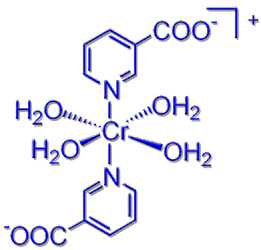Chromium(III) and Glucose tolerance
Chromium is an essential trace element for human and animal nutrition. As early as 1959 in rats, liver necrosis and glucose intolerance were observed, which could be reversed by a chromium containing component found in yeast, meat, and other food - so-called Glucose Tolerance Factor (GTF). The exact structure of the glucose tolerance factor remains unknown. It is, however, certain, that it contains trivalent chromium. It has been postulated that the chromium is complexed by nicotinic acid and amino acids (likely cysteine of the small peptide glutathione). This complex might be an integral part of the membrane receptor for the hormone insuline.
Another chromium containing biomolecule is the oligopeptide chromodulin, which is formed from the amino acids asparagine, glutamine, glycine and cysteine and contains four anion-bridged chromium ions. Chromodulin is part of the self-enhancing system of the insulin signal.
[Cr(nicotinate)2(OH2)4)]+ as a structural model for the glucose tolerance factor |
[Cr3O(propionate)6(OH2)3]+ as a functional model for chromodulin |
|
|
|

